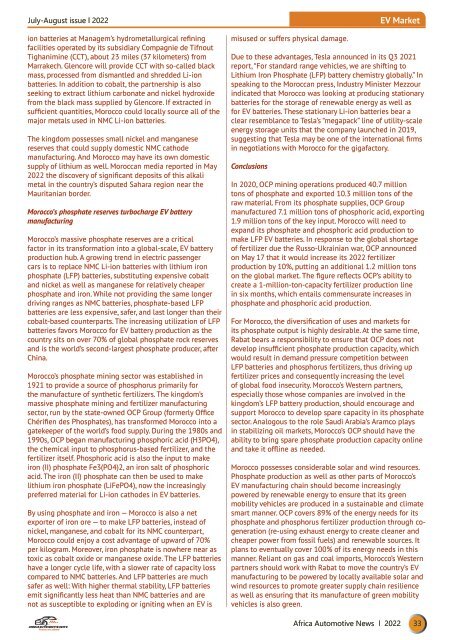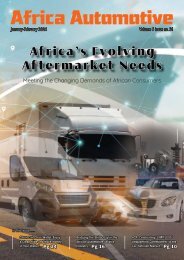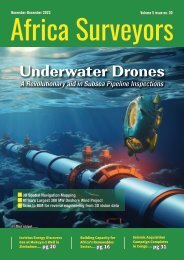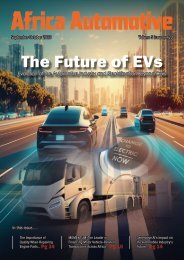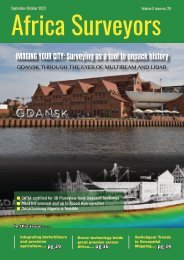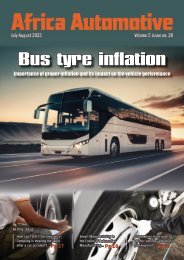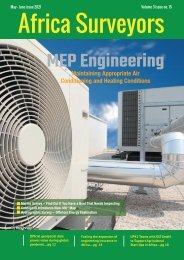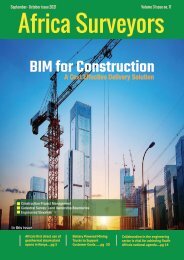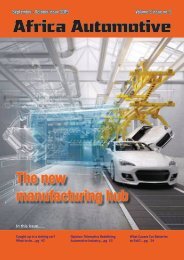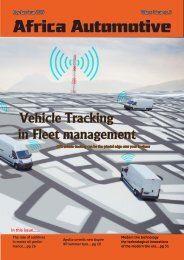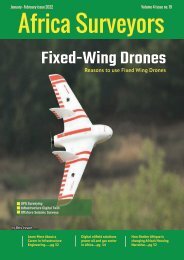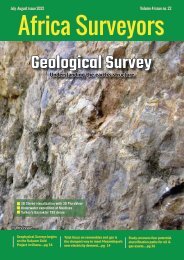Africa Automotive July-August issue 2022
Africa Automotive prides itself to be the ONLY Africa’s leading and MOST authoritative magazine for the automotive industry in Africa with printed copies for the automotive industry decision makers in both government, NGO’s and private sector. The Bi-monthly magazine offers cost effective advertising services that get results and improves growth in the auto B2C and B2B sector, keeping an eye on latest technologies in Africa and across the world, the magazine predominately covers the developments in the Africa auto industry.
Africa Automotive prides itself to be the ONLY Africa’s leading and MOST authoritative magazine for the automotive industry in Africa with printed copies for the automotive industry decision makers in both government, NGO’s and private sector. The Bi-monthly magazine offers cost effective advertising services that get results and improves growth in the auto B2C and B2B sector, keeping an eye on latest technologies in Africa and across the world, the magazine predominately covers the developments in the Africa auto industry.
You also want an ePaper? Increase the reach of your titles
YUMPU automatically turns print PDFs into web optimized ePapers that Google loves.
<strong>July</strong>-<strong>August</strong> <strong>issue</strong> l <strong>2022</strong><br />
ion batteries at Managem’s hydrometallurgical refining<br />
facilities operated by its subsidiary Compagnie de Tifnout<br />
Tighanimine (CCT), about 23 miles (37 kilometers) from<br />
Marrakech. Glencore will provide CCT with so-called black<br />
mass, processed from dismantled and shredded Li-ion<br />
batteries. In addition to cobalt, the partnership is also<br />
seeking to extract lithium carbonate and nickel hydroxide<br />
from the black mass supplied by Glencore. If extracted in<br />
sufficient quantities, Morocco could locally source all of the<br />
major metals used in NMC Li-ion batteries.<br />
The kingdom possesses small nickel and manganese<br />
reserves that could supply domestic NMC cathode<br />
manufacturing. And Morocco may have its own domestic<br />
supply of lithium as well. Moroccan media reported in May<br />
<strong>2022</strong> the discovery of significant deposits of this alkali<br />
metal in the country’s disputed Sahara region near the<br />
Mauritanian border.<br />
Morocco’s phosphate reserves turbocharge EV battery<br />
manufacturing<br />
Morocco’s massive phosphate reserves are a critical<br />
factor in its transformation into a global-scale, EV battery<br />
production hub. A growing trend in electric passenger<br />
cars is to replace NMC Li-ion batteries with lithium iron<br />
phosphate (LFP) batteries, substituting expensive cobalt<br />
and nickel as well as manganese for relatively cheaper<br />
phosphate and iron. While not providing the same longer<br />
driving ranges as NMC batteries, phosphate-based LFP<br />
batteries are less expensive, safer, and last longer than their<br />
cobalt-based counterparts. The increasing utilization of LFP<br />
batteries favors Morocco for EV battery production as the<br />
country sits on over 70% of global phosphate rock reserves<br />
and is the world’s second-largest phosphate producer, after<br />
China.<br />
Morocco’s phosphate mining sector was established in<br />
1921 to provide a source of phosphorus primarily for<br />
the manufacture of synthetic fertilizers. The kingdom’s<br />
massive phosphate mining and fertilizer manufacturing<br />
sector, run by the state-owned OCP Group (formerly Office<br />
Chérifien des Phosphates), has transformed Morocco into a<br />
gatekeeper of the world’s food supply. During the 1980s and<br />
1990s, OCP began manufacturing phosphoric acid (H3PO4),<br />
the chemical input to phosphorus-based fertilizer, and the<br />
fertilizer itself. Phosphoric acid is also the input to make<br />
iron (II) phosphate Fe3(PO4)2, an iron salt of phosphoric<br />
acid. The iron (II) phosphate can then be used to make<br />
lithium iron phosphate (LiFePO4), now the increasingly<br />
preferred material for Li-ion cathodes in EV batteries.<br />
By using phosphate and iron — Morocco is also a net<br />
exporter of iron ore — to make LFP batteries, instead of<br />
nickel, manganese, and cobalt for its NMC counterpart,<br />
Morocco could enjoy a cost advantage of upward of 70%<br />
per kilogram. Moreover, iron phosphate is nowhere near as<br />
toxic as cobalt oxide or manganese oxide. The LFP batteries<br />
have a longer cycle life, with a slower rate of capacity loss<br />
compared to NMC batteries. And LFP batteries are much<br />
safer as well: With higher thermal stability, LFP batteries<br />
emit significantly less heat than NMC batteries and are<br />
not as susceptible to exploding or igniting when an EV is<br />
misused or suffers physical damage.<br />
EV Market<br />
Due to these advantages, Tesla announced in its Q3 2021<br />
report, “For standard range vehicles, we are shifting to<br />
Lithium Iron Phosphate (LFP) battery chemistry globally.” In<br />
speaking to the Moroccan press, Industry Minister Mezzour<br />
indicated that Morocco was looking at producing stationary<br />
batteries for the storage of renewable energy as well as<br />
for EV batteries. These stationary Li-ion batteries bear a<br />
clear resemblance to Tesla’s “megapack” line of utility-scale<br />
energy storage units that the company launched in 2019,<br />
suggesting that Tesla may be one of the international firms<br />
in negotiations with Morocco for the gigafactory.<br />
Conclusions<br />
In 2020, OCP mining operations produced 40.7 million<br />
tons of phosphate and exported 10.3 million tons of the<br />
raw material. From its phosphate supplies, OCP Group<br />
manufactured 7.1 million tons of phosphoric acid, exporting<br />
1.9 million tons of the key input. Morocco will need to<br />
expand its phosphate and phosphoric acid production to<br />
make LFP EV batteries. In response to the global shortage<br />
of fertilizer due the Russo-Ukrainian war, OCP announced<br />
on May 17 that it would increase its <strong>2022</strong> fertilizer<br />
production by 10%, putting an additional 1.2 million tons<br />
on the global market. The figure reflects OCP’s ability to<br />
create a 1-million-ton-capacity fertilizer production line<br />
in six months, which entails commensurate increases in<br />
phosphate and phosphoric acid production.<br />
For Morocco, the diversification of uses and markets for<br />
its phosphate output is highly desirable. At the same time,<br />
Rabat bears a responsibility to ensure that OCP does not<br />
develop insufficient phosphate production capacity, which<br />
would result in demand pressure competition between<br />
LFP batteries and phosphorus fertilizers, thus driving up<br />
fertilizer prices and consequently increasing the level<br />
of global food insecurity. Morocco’s Western partners,<br />
especially those whose companies are involved in the<br />
kingdom’s LFP battery production, should encourage and<br />
support Morocco to develop spare capacity in its phosphate<br />
sector. Analogous to the role Saudi Arabia’s Aramco plays<br />
in stabilizing oil markets, Morocco’s OCP should have the<br />
ability to bring spare phosphate production capacity online<br />
and take it offline as needed.<br />
Morocco possesses considerable solar and wind resources.<br />
Phosphate production as well as other parts of Morocco’s<br />
EV manufacturing chain should become increasingly<br />
powered by renewable energy to ensure that its green<br />
mobility vehicles are produced in a sustainable and climate<br />
smart manner. OCP covers 89% of the energy needs for its<br />
phosphate and phosphorus fertilizer production through cogeneration<br />
(re-using exhaust energy to create cleaner and<br />
cheaper power from fossil fuels) and renewable sources. It<br />
plans to eventually cover 100% of its energy needs in this<br />
manner. Reliant on gas and coal imports, Morocco’s Western<br />
partners should work with Rabat to move the country’s EV<br />
manufacturing to be powered by locally available solar and<br />
wind resources to promote greater supply chain resilience<br />
as well as ensuring that its manufacture of green mobility<br />
vehicles is also green.<br />
<strong>Africa</strong> <strong>Automotive</strong> News l <strong>2022</strong> 33


